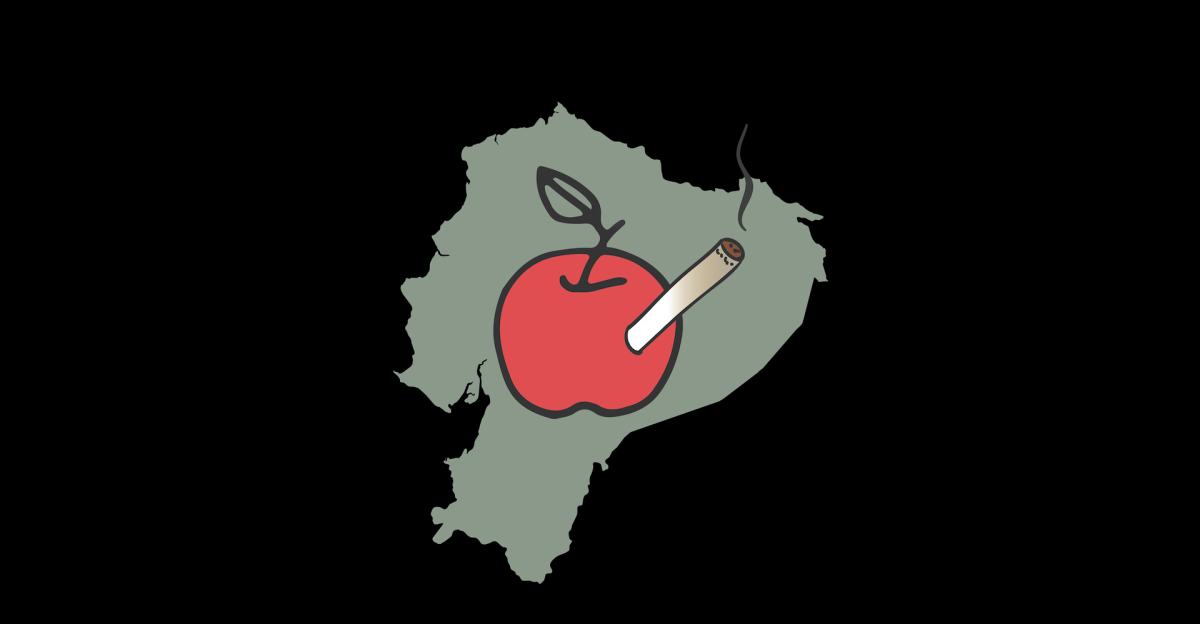
Mikhail Vazquez
Bienvenidos Graphic
It’s my first week as a gringa studying abroad. After classes I find myself waiting at the bus stop in front of the local 4:20 head shop. I get on and take my seat on the bright green, diesel-spewing, NASCAR-like driving adventure. At the front of the bus, above the door I see a portrait of Jesus. Normal in a country where almost every family practices Catholicism, but this time Jesus was accessorized with a marijuana leaf above his head. That’s ironic, I think to myself. As I get off the bus, I pass a woman with what seems to be marijuana-shaped earrings, and a man flaunting the plant on his shirt. Bold. I pass a group of young people buying an apple — and you can bet they are not hungry.
Before leaving on this adventure, I lived in Mexico for the summer, a country with a lot of tension and negativity surrounding drugs. So I presumed that Ecuador would be similar, given that there are also big issues involving South America and drugs. But here I am, in Quito, witnessing a culture that seems to be casual about drugs, or at least marijuana.
However, I soon found out that the drug culture here is not casual at all. Students tell me that it’s not only illegal but usually frowned upon to be involved with marijuana, given the conservative culture and terrors narco-trafficking has had on South America. However, they continue by informing me that a large majority of young students do indeed smoke la hierba. They throw their heads back, dropping some Lerin into their pink eyes and head off.
So, Quito, the heart of the cross created by the Andes mountain range and the middle of the Earth, and a mere 244 kilometers from the Colombian border and 600 kilometers from the Peruvian border … putting this Catholic capital city in the hot seat of controversy and confusion over drugs. ¿Qué pasa?
Colombia and Peru are the leading producers of drugs in South America. And I’m not talking just marijuana. The two countries export an estimated 100 metric tons of cocaina over their borders and into Ecuador yearly, according to the 2016 Overseas Security Advisory Council report. This in-arm’s-reach-accessibility makes it easy and cheap to find drugs in Quito, directly aiding in the raising popularity in consumption.
And this rise in popularity has caused tides to change drastically in Ecuadorian drug reform.
According to In Sight Crime, in 2014 Ecuadorian authorities seized over 10 tons of drugs in the first few months of the year, estimating that 15 percent was intended for domestic sale in Ecuador while the remaining was intended for micro-trafficking as Ecuador was being transformed into more of a port than an end goal for narco-trafficking from Colombia and Peru.
In 2015 there was slight talk of lifting some of the penalties for small drug infractions, putting Ecuador on the path to becoming the second country, behind Uruguay, in South America to reform their drug laws. Instead of jail time, supporters hoped to instead “provide treatment and rehabilitation services for addicts,” according to the Huffington Post. However later in the same year, there was a drastic turn in legislation as Ecuador decided to target the micro-trafficking and local sales. In Sight Crime stated that the new law changed the amount of legal possession of marijuana from up to 300 to 20 grams, and cocaine from 20 to 2 grams.
Was this a desperate attempt to combat the crime that inevitably follows with narco-trafficking? Or was it desperate attempt by the officials here to please a politically conservative country, backtracking the liberal progression of Ecuador?
Either way, the country seems to be confused and stuck in a state of taboo. For the next semester I will surely continue seeing reports on drug busts and drug violence in the city, while also spotting students strolling the streets with that three-day-old apple in hand.